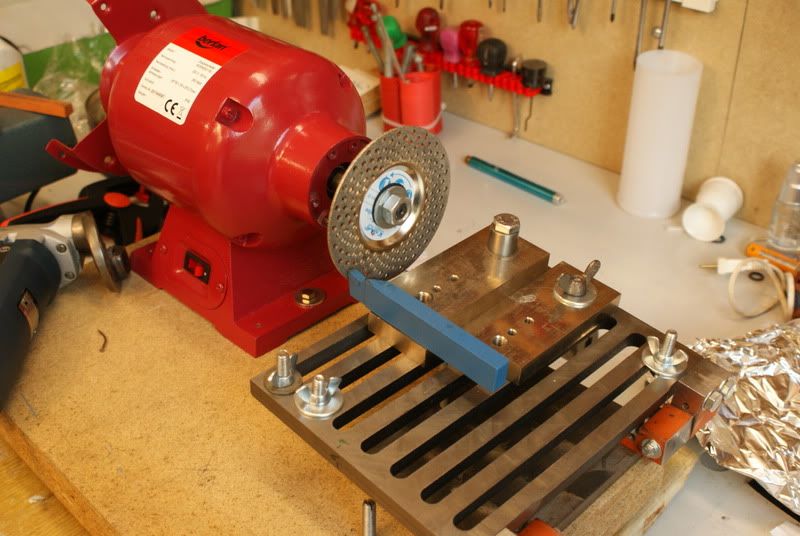Here's from a previous rant on the topic of sharpening scrapers:
Most scraping we home shop types get into is on cast iron and there I've found the best iincluded edge angle to be 90 to 100 degrees. With this angle double ground you can scrape with both sides of the scraper.
The best scraping edge is one that's dead keen; one that has an edge comprised of two mirror smooth surfaces intersecting at a cutting edge. There is no way a keen edge like this can be obtained with a coarse grinding wheel. A grinding wheel is used to shape the scraping edge and a hone or lap is used to maintain its keen edge.
Here's a bald statement: carbide cannot be sharpened to a keen edge by any abrasive media but diamond. It may be worn away with green silicon carbide and appear sharp but magnification of the cutting edge will show it as having an appearance of a broken stone with micro-cracks leading some distance back into the body of the carbide. So resign yourself to the expense of a plated diamond face wheel for the initial shaping of your carbide scrapers.
If you're patient, those cheap Harbor Freight diamond hand stones work well for shaping carbide. Carbide has a low energy of rupture and diamond will plain eat it up unlike most any other abrasive which simple skates off. Build a little wood fixture and you can do as nice a job shaping a carbide scraper as you can with a fancy diamond face wheel grinder. It will just take longer.
Carbide may be lapped with most any metal wheel configured to suit your face wheel grinder. Make the lap of any convenient metal that does not rust. Brass, copper, aluminum; whatever will hold diamond.
A 1/4 HP 1750 RPM cheapo motor mounted on a hunk of plywood is a hell of a start. Install the lap on the motor shaft dial in and mark the face and OD error. Remove the lap and chuck it on the lathe. Using the error readings, dial in the face and OD and take a cut to remove the error. Make the back face parallel to it to perfect intrinsic balance. Re-install. If the error is less than 0.003" use it. here's a picture:
Shop Stuff: Scraping Class (Second imaqage dorn)
Apply diamond "paste" (It's lapping compound guys! Come on!) roll it into the metal with a ball bearing rolling in a slotted handle. Diamond is to most metals as metal chips are to bar soap.
Fab up a rest at your favorite lapping angle. 3 to 5 degrees works for me. Lap the cutting edges of your scrapers to mirror bright surfaces.
HSS may be ground with any good aluminum oxide wheel. It may be honed with most any aluminum oxide slip stone or hard Arkansas. However do not grind HSS with diamond. Diamond and any iron alloy is like Superman and Kryptonite.
For what its worth. Carbide scrapers outlasts HSS by 50 to 1 in cast iron. I get about an hour’s tine scraping with carbide and about a minute with HSS before I have to touch up the cutting edge. Yes, you can scrape longer but sooner or later your arms feel like they're going to fall off and you're making rub marks in the work not cutting actual chips.
A scraper used for precision scraping has an end radius. I prefer a radius about like a coffee can lid for most work. The finer the scraping - the more points per square inch - the smaller the radius. I got a rough formua if anyone is interested.
Finally, scraping is a means of controlled stock removal just like any machining operation. Don't just rub off the blue. Make. Chips. They should look like coffee grounds when rough scraping and pepper when you're finishing.


